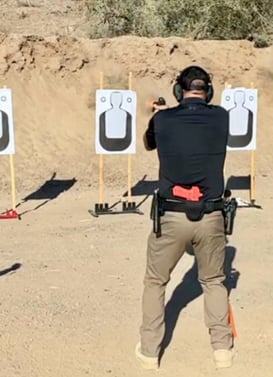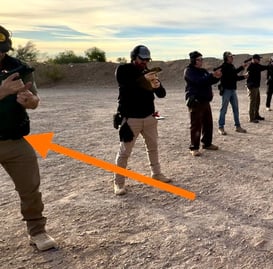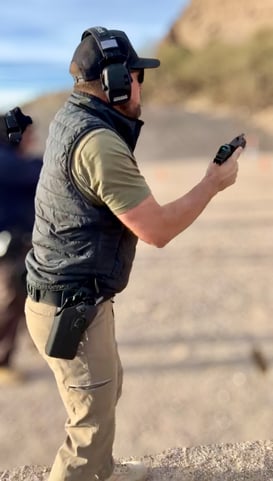Pistol Malfunctions


A Type 1 malfunction, often referred to as a "failure to fire," is the most common malfunction experienced with a semi-automatic pistol. This occurs when you press the trigger, but the gun does not discharge. Here's an explanation of its possible causes and corrective actions:
Causes:
Faulty Ammunition: A dud round or improperly seated primer.
Improperly Seated Magazine: The magazine is not fully inserted, preventing proper feeding.
User Error: Failure to chamber a round or disengage the safety.
Mechanical Issues: Problems with the firing pin or striker.
Symptoms:
A "click" sound instead of a "bang" when pulling the trigger.
The slide is in battery (fully forward), appears normal.
Corrective Action (Tap-Rack-Bang)
This is a simple and effective immediate action (IA) drill:
As a tactically trained shooter this is where you "Step off The X" moving to your left or right before/while fixing your malfunction. Get used to moving those feet!
Tap: Firmly tap the bottom of the magazine to ensure it is seated correctly.
Rack: Pull the slide fully to the rear and release it to chamber a fresh round.
Bang: Reassess the target and attempt to fire again.
If the malfunction persists after performing this drill, a more thorough inspection of the firearm may be necessary. If you are not comfortable with it at this point and you are on a range with a Range Master, notify them of the issue and they will be able to assest you!
Note: Always observe safe firearm handling practices when diagnosing or clearing malfunctions, such as keeping the muzzle pointed in a safe direction and your finger off the trigger.
Type 1, Failure to Fire Malfunction


A Type 2 pistol malfunction, also known as a "stovepipe" malfunction, occurs when a fired casing fails to fully eject and gets caught in the ejection port. This can be caused by various issues such as improper grip, weak ammunition, or issues with the firearm's extractor or ejector.
As you progress through our shooting drills, if your firearm has never had this issue before, it’s likely caused by a compromised grip. Focus on tightening your grip to ensure you’re not the cause of the malfunction while performing the drills.
How to Clear a Type 2 Malfunction (Stovepipe):
Assess the Situation: Identify that the malfunction is a stovepipe by observing a casing sticking out of the ejection port.
Tap: Firmly tap the magazine base to ensure it's fully seated. This ensures the next round can feed properly after clearing the malfunction.
Rack: Use your support hand to pull the slide back completely and release it. This should eject the casing and chamber a new round.
Reassess: Check that the firearm is operational and ready to fire. Reacquire your sights and resume shooting if the situation requires.
Preventive Measures:
Grip Technique: Maintain a firm, high grip on the pistol to minimize limp-wristing, which can disrupt the slide's cycling.
Ammo Quality: Use reliable, factory-loaded ammunition suited for your firearm.
Maintenance: Regularly clean and lubricate your pistol to ensure the extractor and ejector are in good working order.
Parts Inspection: Check for worn or damaged components like the recoil spring or extractor.
Addressing these areas can reduce the likelihood of a stovepipe malfunction in the future.
Type 2, Failure to Eject Malfunction


A Type 1 malfunction, often referred to as a "failure to fire," is the most common malfunction experienced with a semi-automatic pistol. This occurs when you press the trigger, but the gun does not discharge. Here's an explanation of its possible causes and corrective actions:
Causes:
Faulty Ammunition: A dud round or improperly seated primer.
Improperly Seated Magazine: The magazine is not fully inserted, preventing proper feeding.
User Error: Failure to chamber a round or disengage the safety.
Mechanical Issues: Problems with the firing pin or striker.
Symptoms:
A "click" sound instead of a "bang" when pulling the trigger.
The slide is in battery (fully forward), appears normal.
Corrective Action (Tap-Rack-Bang)
This is a simple and effective immediate action (IA) drill:
As a tactically trained shooter this is where you "Step off The X" moving to your left or right before/while fixing your malfunction. Get used to moving those feet!
Tap: Firmly tap the bottom of the magazine to ensure it is seated correctly.
Rack: Pull the slide fully to the rear and release it to chamber a fresh round.
Bang: Reassess the target and attempt to fire again.
If the malfunction persists after performing this drill, a more thorough inspection of the firearm may be necessary. If you are not comfortable with it at this point and you are on a range with a Range Master, notify them of the issue and they will be able to assest you!
Note: Always observe safe firearm handling practices when diagnosing or clearing malfunctions, such as keeping the muzzle pointed in a safe direction and your finger off the trigger.
Type 3, Failure to Extract Malfunction


A Type 2 pistol malfunction, also known as a "stovepipe" malfunction, occurs when a fired casing fails to fully eject and gets caught in the ejection port. This can be caused by various issues such as improper grip, weak ammunition, or issues with the firearm's extractor or ejector.
As you progress through our shooting drills, if your firearm has never had this issue before, it’s likely caused by a compromised grip. Focus on tightening your grip to ensure you’re not the cause of the malfunction while performing the drills.
How to Clear a Type 2 Malfunction (Stovepipe):
Assess the Situation: Identify that the malfunction is a stovepipe by observing a casing sticking out of the ejection port.
Tap: Firmly tap the magazine base to ensure it's fully seated. This ensures the next round can feed properly after clearing the malfunction.
Rack: Use your support hand to pull the slide back completely and release it. This should eject the casing and chamber a new round.
Reassess: Check that the firearm is operational and ready to fire. Reacquire your sights and resume shooting if the situation requires.
Preventive Measures:
Grip Technique: Maintain a firm, high grip on the pistol to minimize limp-wristing, which can disrupt the slide's cycling.
Ammo Quality: Use reliable, factory-loaded ammunition suited for your firearm.
Maintenance: Regularly clean and lubricate your pistol to ensure the extractor and ejector are in good working order.
Parts Inspection: Check for worn or damaged components like the recoil spring or extractor.
Addressing these areas can reduce the likelihood of a stovepipe malfunction in the future.